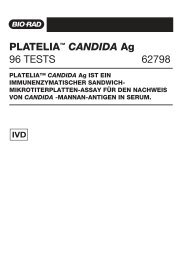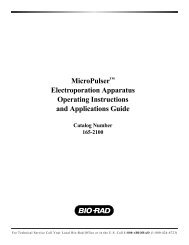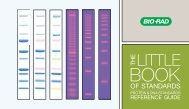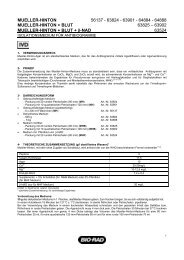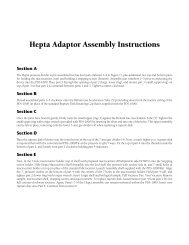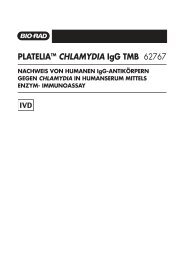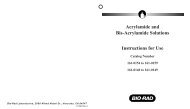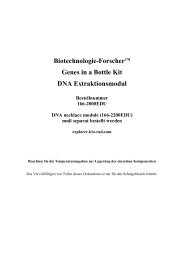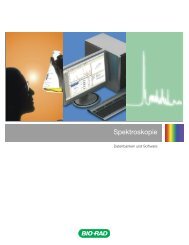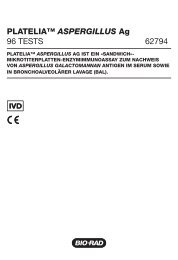Protein Expression and Purification Series - Bio-Rad
Protein Expression and Purification Series - Bio-Rad
Protein Expression and Purification Series - Bio-Rad
Create successful ePaper yourself
Turn your PDF publications into a flip-book with our unique Google optimized e-Paper software.
CHAPTER 1<br />
BACKGROUND<br />
<strong>Protein</strong> <strong>Expression</strong> <strong>and</strong> <strong>Purification</strong> <strong>Series</strong><br />
the expression of a required metabolic enzyme that has otherwise been deleted from the host organism.<br />
The promoter controls the level of gene expression. It can be either constitutive, meaning that it is always<br />
active <strong>and</strong> there is no control over when the protein of interest is expressed, or inducible, meaning that<br />
its activity can be triggered by external factors. Examples of inducible promoters are the heat shock<br />
promoters, which are activated by a change in temperature. These promoters are derived from naturally<br />
occurring sequences in organisms that need to express a different protein when they are in a warm<br />
environment versus a cold one. Other inducible promoters are activated by the addition of a chemical such<br />
as lactose or its analog IPTG in the case for the LacZ promoter in E. coli. The T7 promoter is an example of<br />
a chemically induced promoter system. For industrial applications, genes for the protein of interest tend to<br />
be under inducible control.<br />
The copy number of a plasmid depends on the origin of replication present in the plasmid. The origin of<br />
replication determines the level of control<br />
of replication of the plasmid, <strong>and</strong> if the<br />
plasmid is under a relaxed control more<br />
copies can be made. The size of the<br />
plasmid <strong>and</strong> size of the insert also affect<br />
the number of copies. If there are more<br />
copies of the plasmid in cells it is possible<br />
for them to produce more protein than<br />
cells that have fewer copies of the plasmid.<br />
Plasmids used for cloning such as pUC<br />
tend to be higher copy number while<br />
plasmids used for protein expression tend<br />
to be larger <strong>and</strong> have lower copy number.<br />
To facilitate the purification of the<br />
expressed protein, DNA sequences<br />
coding for a signal (amino acid sequence)<br />
that targets the protein of interest to be<br />
secreted into the periplasmic region of E.<br />
coli or into the extracellular medium for<br />
eukaryotic cells, can be fused to the gene<br />
of interest. Other tags that are commonly<br />
added are fusion proteins to increase the<br />
solubility of the expressed protein (such as<br />
glutathione-S-transferase, GST) or affinity<br />
tags (polyhistidine or GST tags) that can be<br />
used to selectively purify the recombinant<br />
protein.<br />
Figure 1.1. Gene Design For Recombinant <strong>Protein</strong> Production.<br />
Choice of Cell <strong>Expression</strong> System<br />
Once the cell expression system has been determined for recombinant protein production, the gene<br />
construct to express the recombinant protein needs to be designed. This could be as simple as taking<br />
the coding sequence of the gene of interest as it exists in the parent organism <strong>and</strong> inserting this sequence<br />
into an expression plasmid for the cell system being used. However, this usually does not produce optimal<br />
levels of recombinant protein when the gene is expressed in a heterologous system (a cell or organism<br />
different from the one where the gene is naturally found) because the preferred codon usage for various<br />
species differs. For example, the codon GGA for glycine can be found at a frequency of 16.4 times per<br />
1000 codons in human genes while it is only used 9.5 times per 1000 codons in E. coli genes. Therefore,<br />
there is a chance that leaving this codon in the recombinant gene might lead to lower levels of recombinant<br />
expression due to a scarcity of tRNA molecules for GGA.<br />
36 Chapter 1: Recombinant <strong>Protein</strong> <strong>Expression</strong> & <strong>Purification</strong>




